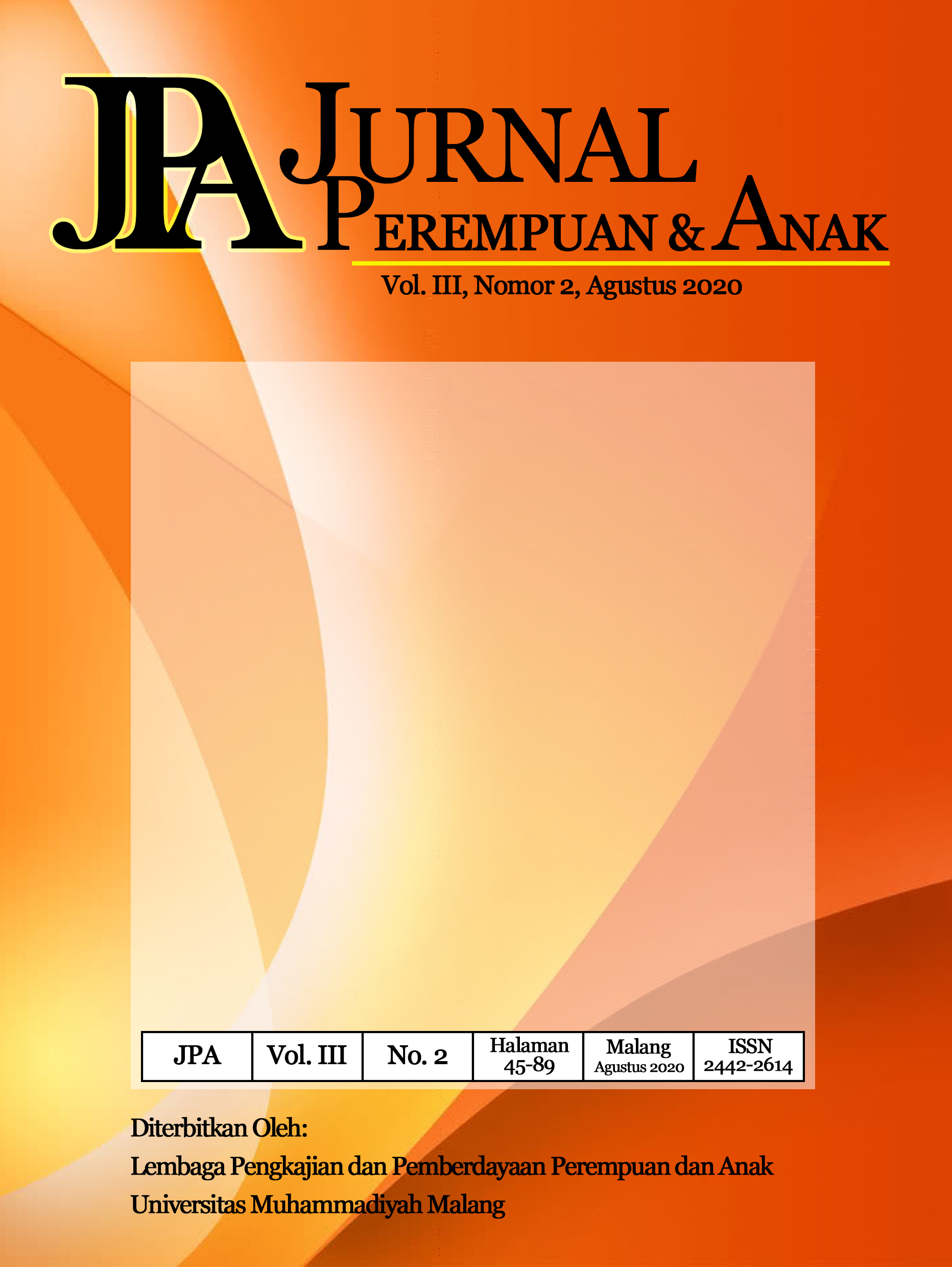Higlighting the Gender Perspective of Family Planning in Malang City
DOI:
https://doi.org/10.22219/jpa.v3i2.16517Keywords:
Gender perspective, family planning, long-term contraception method, short-term contraception method, Unmet needAbstract
The Gender perspective of family planning participants in Malang, especially in the KB village, Bareng, because according to the Women's Empowerment, Child Protection, Population and Family Planning (DP3AP2KB) Office, is located at Jl. Ki Ageng Gribig No.5 Malang Postal Code 65173. Having a vision that is "The realization of community empowerment, population control and the realization of gender equality and protection of women and children". BKBPM also mediates the strategy and policy direction planned by the Malang city government, namely increasing the empowerment of the poor, increasing the empowerment and protection of women and children. As well as improving the quality of family planning and family welfare (DP3AP2KB, 2016).
The results of the discussion stated that the number of family planning participants in RW 08 was 329 or 54.92 percent of the number of PUS (couples of childbearing age) of 599. The most enjoyed contraceptive method is an IUD of 98 or 29.78 percent. Whereas for MKJP KB (long-term method of family planning contraception) participants (Long Term Contraception Method) by 13 or 40.42 percent, and the most usage was NON MKJP which was 59.74 percent.
Based on the Gender Perspective, only 66 of the 329 KB participants or only 20% of the male participants are involved. This is based on the results of interviews in the family many mothers who do not approve of her husband using the Vasectomy Contraception method, also due to suspicion if the husband uses it will be misused misused on other women (anonymous), other than that the causes of Unmet need factors: Side effects on health, prohibitions from spouse or husband, discomfort, costs to be incurred, do not want to bother, subjective experience does not use contraception does not occur in pregnancy.
Downloads
References
Adi, Isbandi Rukminto. 2007. Perencanaan Partisipatoris Berbasis Aset Komunitas: dari Pemikiran Menuju Penerapan. Depok: FISIP UI Press. Hlm: 27
Arfida Br, 2019. Pengarus Utamaan Gender. Materi perkuliahan Demografi Kependudukan.
Depkes. 2107. Kampung KB: Strategis Memberdayakan Masyarakat. Jakarta: Depkes.
Hasibuan, Ali Fikri. 2015. Pemberdayaan UPPKS Cendrawasih Berbasis Pencatatan Keuangan di Kota Tanjung Balai. Dimuat dalam Jurnal Pengabdian Kepada Masyarakat Vo. 21 Nomor 81 Tahun XXI September 2015
Kementerian Kesehatan Republik Indonesia. 2018. Kampung KB: Inovasi Strategis Memberdayakan Masyarakat. Jakarta: Depkes.
Mardiyono. 2017. Pemberdayaan Keluarga Melalui Kampung KB Dalam Upaya Peningkatan Program KKBPK dan Terkait di Jawa Timur (Studi di Kabupaten Bondowoso dan Bangkalan). Peneliti Madya Perwakilan BKKBN Jawa Timur. Jurnal Keluarga Berencana, Vol 2 No. 1.
Nugroho, Bayu Aditya. 2010. Analisis Dampak Berdirinya Mall Olympic Garden (MOG) terhadap Sosial Ekonomi Masyarakat di Kelurahan Bareng Kec Klojen Kota Malang. Undergraduate Theses from JIPTUMMPP, Development Ekonomic Study of UMM
Team, 2015 Kampung KB Bareng, Kota Malang.
Zuhriyah, Aminatuz, Sofwan Indarjo dan Bambang Budi Raharjo. 2017. Kampung Keluarga Berencana Dalam Peningkatan Efektivitas Program Keluarga Berencana. Higeia Journal of Public Health Research and Development - HIGEIA 1 (4) (2017). P-ISSN 1475-362846 E- ISSN 1475-2225
Downloads
Published
How to Cite
Issue
Section
License
Copyright (c) 2020 Arfida Boedirochminarni, Zainal Arifin

This work is licensed under a Creative Commons Attribution-ShareAlike 4.0 International License.
Authors who publish with Jurnal Perempuan dan Anak (JPA) agree to the following terms:
- For all articles published in Jurnal Perempuan dan Anak (JPA), copyright is retained by the authors. Authors give permission to the publisher to announce the work with conditions. When the manuscript is accepted for publication, the authors agree to automatic transfer of the publishing right to the publisher.
- Authors retain copyright and grant the journal right of first publication with the work simultaneously licensed under a Creative Commons Attribution-ShareAlike 4.0 International License that allows others to share the work with an acknowledgment of the work's authorship and initial publication in this journal.
- Authors are able to enter into separate, additional contractual arrangements for the non-exclusive distribution of the journal's published version of the work (e.g., post it to an institutional repository or publish it in a book), with an acknowledgment of its initial publication in this journal.
- Authors are permitted and encouraged to post their work online (e.g., in institutional repositories or on their website) prior to and during the submission process, as it can lead to productive exchanges, as well as earlier and greater citation of published wor (See The Effect of Open Access).
This work is licensed under a Creative Commons Attribution-ShareAlike 4.0 International License








